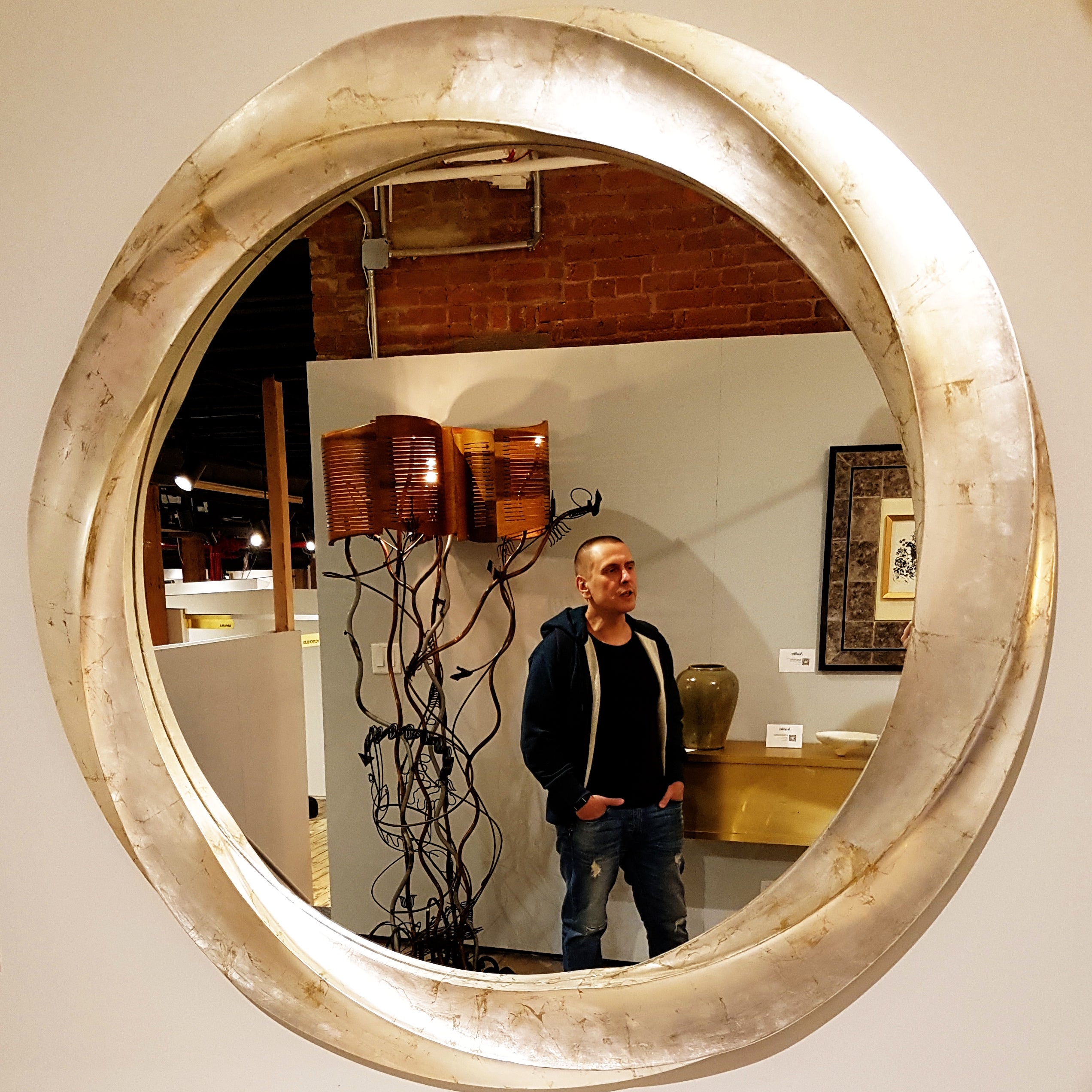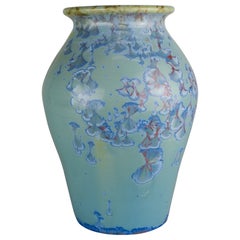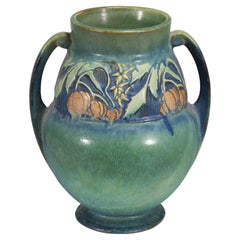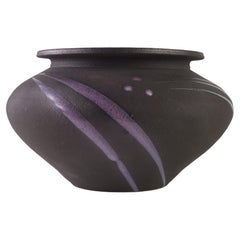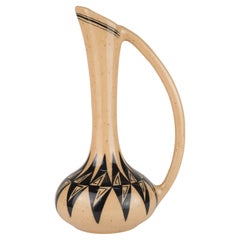Video Loading
Want more images or videos?
Request additional images or videos from the seller
1 of 15
Ashworth Blue Flambé Vase, English Art Pottery 1909-1914
Price:$1,350
$1,770List Price
About the Item
- Similar to:Ruskin Pottery (Manufacturer)Bernard Moore (Designer)
- Dimensions:Height: 6.3 in (16.01 cm)Diameter: 6.25 in (15.88 cm)
- Style:Arts and Crafts (Of the Period)
- Materials and Techniques:
- Place of Origin:
- Period:
- Date of Manufacture:1909-1914
- Condition:Wear consistent with age and use. 2mm fleabite on the base. Please see the last image.
- Seller Location:Clifton Springs, NY
- Reference Number:1stDibs: LU4421145980522
Roman Erlikh
Roman Erlikh is a professional woodworker with over 20 years’ experience. Roman Erlikh Studio creates bespoke and limited edition contemporary furniture and art objects. His first furniture collections were inspired by traditional Art Deco and Biedermeier styles interpreted through a modern lifestyle demands. Stepping away from merely utilitarian view of everyday objects, his recent collections are filled with meaningful textual context while incorporating traditional and modern woodworking techniques. Roman is using practical function as a common denominator to create emotionally charged art objects, blurring the boundary between art and function. While appreciating possibilities of ordinary materials, Roman is developing new mixed media multilayered composite varnishes and utilizes decorative gilding and mica veneer to actively engage ambient light, giving an additional aspect to relation of his objects to their environment. The decision to work in custom format was based on environmental concerns and opposition to culture of mass production and pure consumerism. The choice of materials was heavily influenced by sustainability and environmental concerns. All objects are made locally in the Brooklyn Navy Yard workshop. Elimination of storage and transportation needs for mass-produced furniture in lieu of creating a custom made objects on demand allows us to reduce waste of materials and energy.
About the Seller
5.0
Platinum Seller
Premium sellers with a 4.7+ rating and 24-hour response times
Established in 2011
1stDibs seller since 2019
218 sales on 1stDibs
Authenticity Guarantee
In the unlikely event there’s an issue with an item’s authenticity, contact us within 1 year for a full refund. DetailsMoney-Back Guarantee
If your item is not as described, is damaged in transit, or does not arrive, contact us within 7 days for a full refund. Details24-Hour Cancellation
You have a 24-hour grace period in which to reconsider your purchase, with no questions asked.Vetted Professional Sellers
Our world-class sellers must adhere to strict standards for service and quality, maintaining the integrity of our listings.Price-Match Guarantee
If you find that a seller listed the same item for a lower price elsewhere, we’ll match it.Trusted Global Delivery
Our best-in-class carrier network provides specialized shipping options worldwide, including custom delivery.You May Also Like
Bernard Moore Art Nouveau Flambe Glazed Art Pottery Vase
By Bernard Moore
Located in Bishop's Stortford, Hertfordshire
Bernard Moore (British, 1850-1935) Art Nouveau flambe glazed art pottery vase dating from around 1905. The vase of rounded bulbous shape is lightly ...
Category
Antique Early 1900s English Art Nouveau Vases
Materials
Pottery
Large Antique English Morley & Ashworth 'Mason's' Ironstone Pottery Angel Vase
By Mason's Ironstone
Located in Portland, OR
Rare, antique, large 19th century exhibition ironstone pottery vase by Morley & Ashworth, for the 1862 International Exhibition.
Morley & Ashworth had taken over the designs of Mas...
Category
Antique Mid-19th Century English Aesthetic Movement Vases
Materials
Ironstone
$938 Sale Price
24% Off
H 20.375 in Dm 10.75 in
Asian Flambe Studio Pottery Vase
By Kyoto Pottery
Located in Atlanta, GA
A garlic bottle vase in an archaic Chinese form, but likely Japanese in origin. Several circumventing grooves however, suggest a more modern age. It was done in a brilliant purple glaze over a robin egg blue background glaze. The bubbling and bursting effects during the firing renders the surface an artistic spotting effect. The color pallet recalls the Classic Jun Yao...
Category
Antique Late 19th Century Japanese Japonisme Ceramics
Materials
Ceramic
Oxblood and Blue Flambé Art Deco Glazed Pottery Vase, Scandinavia, 1936
Located in Esbjerg, DK
Scandinavian pottery vase decorated in a purple toned blue flambé main-glaze and an over-glaze or drip glaze in Oxblood red. Unidentified Scandinavian ceramist: EHP and its dated 1936. The style of this piece is reminiscent of Chinese Chien Lung.
Category
Vintage 1930s Scandinavian Art Deco Vases
Materials
Pottery
$320 Sale Price
20% Off
H 4.73 in Dm 5.52 in
Awaji Pottery Art Deco Japanese Vintage Studio Muscle Vase Blue Green Flambe
By Awaji Pottery
Located in Wilton, CT
Awaji Pottery "muscle" vase in Art Deco form with outstreched handles and frothy blue green flambe glaze, circa 1930. Impressed marks. Measure: 6" high, 7 1/2" across handles, 6" dee...
Category
Vintage 1930s Japanese Art Deco Vases
Materials
Pottery
$395
H 6 in W 7.5 in D 6 in
Belgian Art Nouveau Twin Handled Flambe Glazed Art Pottery Vase
Located in Bishop's Stortford, Hertfordshire
A very stylish Art Nouveau Belgian twin handled art pottery vase decorated in flambe glazes and dating from around 1900. The lightly potted earthenware vase stands on a round partial...
Category
Antique Early 1900s Belgian Art Nouveau Vases
Materials
Earthenware
$324
Free Shipping
H 4.73 in Dm 4.93 in
Pair Awaji Pottery Yellow Flambe Vases
By Awaji Pottery
Located in Wilton, CT
Pair vintage Awaji pottery vases in bright yelow flambe glazes, circa 1930. With slightly cinched waists and little handles curling from the wide shoulders. Impressed marks. 6" high,...
Category
Vintage 1930s Japanese Art Deco Vases
Materials
Pottery
Vintage Awaji Pottery Muscle Vase Art Deco Yellow Flambe
By Awaji Pottery
Located in Wilton, CT
Vintage Awaji pottery "muscle" vase with upturned bicep handles and terrific yellow flambe glaze, circa 1930. Hand turned. Impressed marks on base. 6" high, 7 1/2" across, 6" deep. E...
Category
Vintage 1930s Japanese Art Deco Vases
Materials
Pottery
Large Art Nouveau French Pottery Iridescent Flambe Vase, circa 1900
Located in New York, NY
Impressed mark of Alphonse Cytere who established the Rambervillers art studio in 1903. Also marked Unis France.
Category
Early 20th Century French Vases
Vintage Moorcroft Flambe Glazed Leaf and Berry Art Pottery Vase
By Moorcroft Pottery
Located in Hamilton, Ontario
This art pottery vase was done by the Moorcroft Pottery company of England in circa 1939 using their 'flambe' glaze with their 'Leaf & Berry' pattern. The one side of the vase is don...
Category
Early 20th Century English Art Deco Vases
Materials
Pottery
More From This Seller
View AllJon Price Large Blue Crystalline Glaze Vase, California Art Pottery
Located in Clifton Springs, NY
Rare, sculptural vase was made of pure, high-fire porcelain and glazed both on the inside and the outside. Blue and pink highly detailed crystals on crackled blue background were gr...
Category
Late 20th Century American Post-Modern Vases
Materials
Ceramic
Roseville Baneda Double Handle Green Vase, 1932 American Art Pottery
By Roseville Pottery
Located in Clifton Springs, NY
Vintage Baneda line vase features twin loop handles, wide band of decor in the upper part of the vase, and beautiful green glaze with dripping blue glaze accents. This is the model 5...
Category
Vintage 1930s American Arts and Crafts Vases
Materials
Ceramic, Pottery
Michael Cho Art Pottery Postmodern Vase Black
Located in Clifton Springs, NY
ostmodern bulbous ceramic vase was hand thrown and hand decorated by Michael Cho with black matte finish and raised pink and green abstract geometric decor...
Category
Late 20th Century American Modern Vases
Materials
Ceramic, Pottery
Bud Vase Ewer Pueblo Art Pottery Signed
Located in Clifton Springs, NY
Graceful bud vase in shape of an ewer is hand thrown and hand decorated with traditional abstract design in black on mottled coral pink glaze background. The placement of the design is sensitively proportioned to the shape of the vase, creating an optical effect that guides the eye.
The vase is signed on the bottom by the artist, Dorothy Stewart.
Category
Late 20th Century American Native American Vases
Materials
Ceramic
Stoin for Burley Winter Pair of Vases, American Art Deco Pottery 1930s
Located in Clifton Springs, NY
Vintage pair of Art Deco ceramic vases feature matte mottled and splash glaze in green and pastel pink palette. The minimal, but elegant shape of the vases, created in contemporary Art Deco style with strong Arts and Crafts influence, was used as a canvas to explore the effects that can be achieved with different applications of the tints and shades of green colored glaze on the pale pink background. The vases form the cohesive pair that offers an additional visual interest in glaze variations on surface decoration.
The vases are marked with the identical model numbers on the bottoms; the definitive attribution can be made by various printed and online resources.
The Burley Winter...
Category
Early 20th Century American Arts and Crafts Vases
Materials
Ceramic, Pottery
Roseville Pottery Earlam Tourmaline Blue Vase, Frank Ferrel 1930s
By Roseville Pottery
Located in Clifton Springs, NY
The vintage vase features a blended blue matte glaze with dripping creamy yellow semi-glossy glaze effect around the rim on both inner and outer surfaces and on handles. The vase has...
Category
Early 20th Century American Art Deco Vases
Materials
Ceramic, Pottery
Recently Viewed
View AllMore Ways To Browse
Chinese Flambe
English Pottery Blue
Imperial Hotel
Royal Doulton Arts And Crafts
Lustre Ware
Royal Lancastrian
Chelsea Pottery
Ashworth Brothers
Shaw Of London Furniture History
Green And White Chinese Large Urn
Royal Doulton Flambe Art Pottery Vase
Ashworth Bros
John Goddard
Japanese Green Pottery
Japanese Majolica
Jean Claude Novaro
Jean Massier
Jingdezhen Vase
